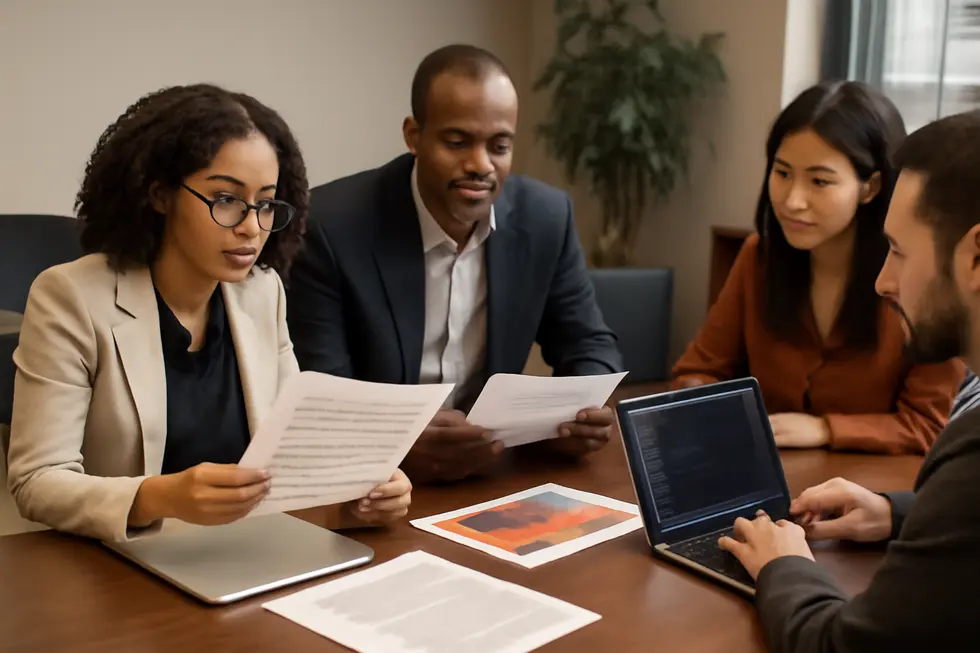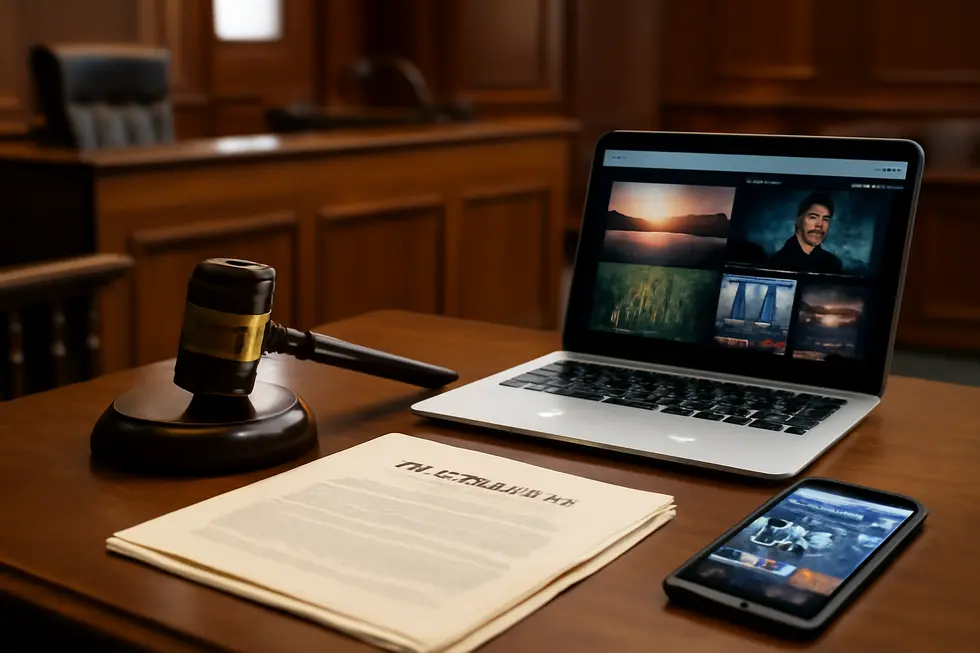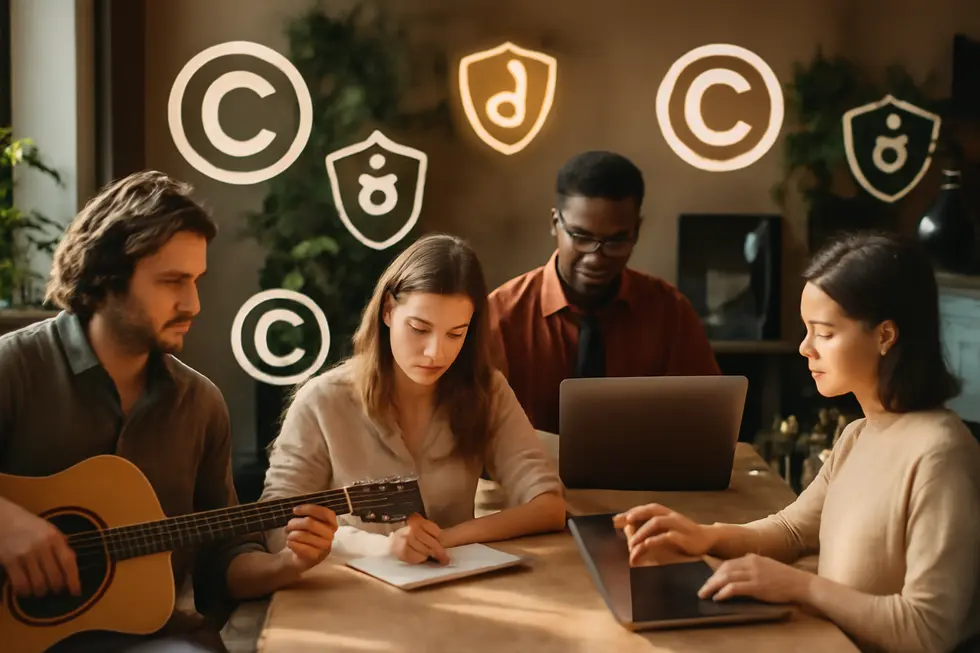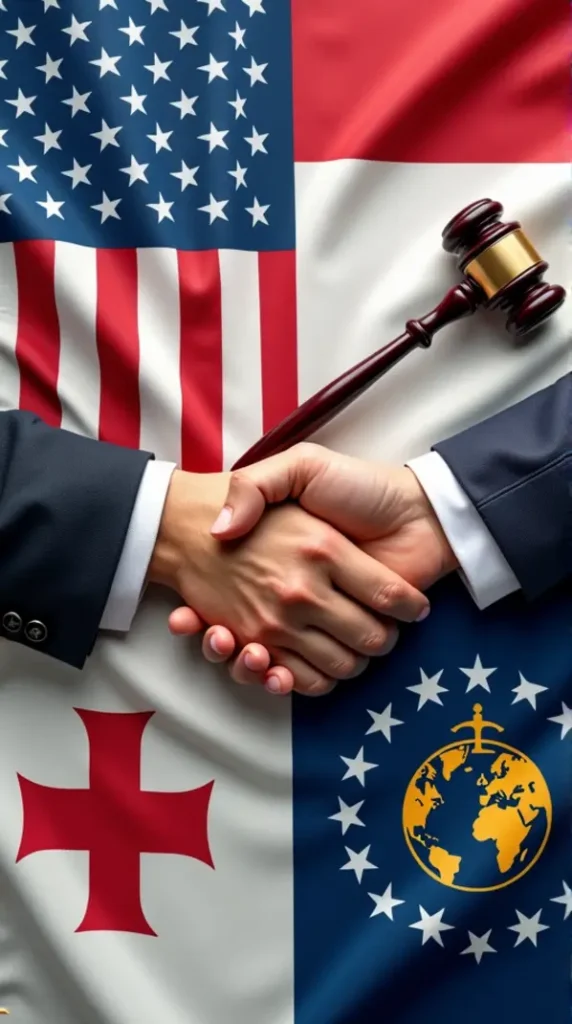Introduction
Copyright plays a crucial role in safeguarding the creative assets that underpin many businesses today. For business owners, understanding copyright is essential to protect original works, maximize commercial opportunities, and avoid costly legal challenges. This article explores the foundational principles of copyright, highlighting how these laws grant exclusive rights to creators. It then delves into the practical application of these rights, including recognized exceptions and enforcement strategies, ensuring businesses can navigate copyright complexities confidently. Finally, it examines the broader economic and societal implications of copyright, illustrating its influence on innovation, creativity, and the balance between private rights and public interests. By unpacking these interconnected aspects, business owners gain a comprehensive understanding of copyright, equipping them to protect and grow their enterprises sustainably.
Tables of Contents
Chapter 1: Understanding Copyright Copyright Copyright: Fundamental Concepts and Legal Protections
- The Pillars of Copyright Protection: How Originality and Fixation Shape Legal Rights
- Navigating the Boundaries of Copyright: What Works Are Protected and the Exclusive Rights They Grant
- Navigating Copyright’s Automatic Safeguards, Registration Benefits, and Fair Use Balances
Chapter 2: Applications and Limitations in Copyright Copyright Copyright: Rights, Exceptions, and Enforcement
- Balancing Protection and Public Interest: How Copyright Safeguards Creativity and Economic Value
- Navigating Copyright Exceptions: Balancing Creators’ Rights and the Public Good
- Navigating Legal Enforcement and Ownership Complexities in Copyright Protection
Chapter 3: Economic and Societal Impact of Copyright: Driving Creativity, Innovation, and Balanced Growth
- How Copyright Fuels Economic Expansion and Industry Innovation in Creative Sectors
- Balancing Creative Incentives and Legal Exceptions: Navigating Copyright’s Role in Innovation and Society
- Navigating Societal Equity and Policy Challenges in Copyright’s Role for Creativity and Innovation
Chapter 1: Understanding Copyright Copyright Copyright: Fundamental Concepts and Legal Protections

1. The Pillars of Copyright Protection: How Originality and Fixation Shape Legal Rights
Copyright protection rests on two essential pillars: originality and fixation.
Originality requires that a work be independently created by a human author and contain a minimal degree of creativity. This does not mean the work must be novel or unique in an absolute sense, but it must reflect some creative spark, distinguishing it from mere ideas, facts, or procedures, which copyright law explicitly excludes. For example, a handwritten poem or a uniquely arranged photograph can meet this threshold, while a simple list of facts or a commonplace phrase cannot.
Fixation is equally critical—it demands that the creative work be fixed in a tangible medium of expression, allowing it to be perceived, reproduced, or communicated. This tangible medium can take many forms, including written text on paper, digital files, audio recordings, or visual art produced on canvas or digitally. Conceptual ideas alone, without expression in a fixed form, receive no copyright protection. Fixation ensures the work is accessible beyond the moment of its creation and can be shared or analyzed.
Together, originality and fixation establish a clear boundary for copyright protection, ensuring that only creative expressions that are both human-made and embodied in a perceptible format qualify. Once these criteria are met, copyright protection arises automatically without needing registration or formal publication, though registration can enhance legal enforceability.
The owner of the copyright gains exclusive rights to reproduce, distribute, perform, display, or adapt the work, empowering creators to control and benefit from their intellectual endeavors. This foundational understanding of originality and fixation helps define what types of creative works receive legal safeguarding within the larger copyright framework.
For a deeper exploration of these principles, the University of Memphis Copyright Basics guide offers a thorough resource. Additionally, exploring the basics of copyright law can provide valuable context on these core legal standards and their implications for creators and users alike.
2. Navigating the Boundaries of Copyright: What Works Are Protected and the Exclusive Rights They Grant
Navigating the Boundaries of Copyright: What Works Are Protected and the Exclusive Rights They Grant
Copyright protection is inherently tied to original works of authorship that are fixed in a tangible medium of expression. This means that a copyright covers the unique way authors express their ideas when captured in physical or digital form, such as writings, musical scores, photographs, software code, architectural designs, or films. Importantly, copyright does not extend to ideas, facts, or methods themselves—only the actual creative expression is protected. For instance, a novel’s storyline idea isn’t covered, but the written text itself is.
The exclusive rights granted by copyright law empower the holder to control key uses of their work. These rights typically include reproducing the work, creating derivative versions based on it, distributing copies to the public, and publicly performing or displaying the work. These rights can be transferred or licensed, allowing copyright owners to authorize others to use their creations while retaining ultimate control. This legal framework ensures creators can benefit economically and maintain artistic integrity.
Protection attaches automatically when the work is fixed, but registering the copyright offers significant enforcement advantages, such as eligibility for statutory damages if infringement occurs. The duration of copyright usually spans the author’s life plus 70 years in many jurisdictions, balancing creator rights with eventual public domain access.
Together, these provisions form a crucial element of intellectual property law, safeguarding creators’ original expressions and incentivizing innovation. To explore the detailed protections and exclusive rights copyright grants, refer to authoritative resources such as the basics of copyright law for businesses and creators.
For a comprehensive legal reference on these rights, see U.S. Code Title 17, Section 106: https://www.law.cornell.edu/uscode/text/17/106
3. Navigating Copyright’s Automatic Safeguards, Registration Benefits, and Fair Use Balances
Copyright protection arises automatically the moment an original work is fixed in a tangible medium, such as writing a manuscript, recording music, or saving digital files. This immediate legal safeguard means creators own exclusive rights without needing formal registration or specific notices. However, while automatic protection establishes ownership, registering a work with the U.S. Copyright Office offers crucial legal advantages, especially when asserting rights in court. Registration requires submitting an application tailored to the work’s category, paying a filing fee typically ranging from $45 to $125, and providing copies of the work. Successfully registered works gain the ability to pursue infringement lawsuits, eligibility for statutory damages, and attorney’s fees, elevating enforcement options dramatically.
Despite the strong protections copyright grants, the law balances these with carefully defined exceptions known as fair use. This doctrine permits limited use of copyrighted material without permission for socially valuable purposes like criticism, commentary, news reporting, teaching, scholarship, and research. When assessing fair use, courts consider factors such as the purpose and character of the use, the nature of the copyrighted work, the quantity used, and its impact on the market for the original. This nuanced approach ensures copyright holders retain control while enabling important creativity and discourse that enrich public knowledge.
Together, the automatic nature of copyright protection, the enhanced benefits of registration, and the flexibility of fair use create a comprehensive legal framework. This framework empowers creators to protect their original works confidently while supporting public interests in education and innovation. For those seeking detailed guidance on registering copyrights, resources like the U.S. Copyright Office’s online system offer step-by-step instructions and support. This deeper understanding strengthens an author’s ability to manage their intellectual property within the broader landscape of copyright law.
For readers interested in safeguarding creative works beyond registration, learn more about the benefits of copyright registration for business.
Chapter 2: Applications and Limitations in Copyright Copyright Copyright: Rights, Exceptions, and Enforcement

1. Balancing Protection and Public Interest: How Copyright Safeguards Creativity and Economic Value
Copyright serves a dual purpose: it protects original creative works while fostering economic growth through legal exclusivity. Creators of literary pieces, visual art, music, and other original content receive exclusive rights to reproduce, distribute, and publicly perform their works. This legal control empowers creators and businesses to prevent unauthorized use, preserving not only artistic integrity but also significant economic investments. Beyond control, copyrights become valuable assets, often monetized via licensing deals or sales, which support ongoing creative efforts and innovation.
However, copyright protection operates within essential boundaries to maintain equilibrium between private rights and public interest. It does not cover ideas, facts, government works, or short phrases—areas that require different legal measures like patents or trademarks. A foundational limitation is the fair use doctrine, allowing certain uses such as criticism, education, news reporting, and research without prior authorization. This exception is crucial for promoting academic inquiry and cultural commentary while respecting creators’ rights.
The legal framework also recognizes that copyright emerges automatically upon creation and fixation, but voluntary registration strengthens enforcement options through access to statutory damages and attorney fees. Duration limits further define protection scope, with older works eventually entering the public domain to stimulate new creations.
This nuanced balance ensures copyright not only secures creators’ economic and moral interests but also supports public access and ongoing innovation. For a deeper understanding of these practical applications, see copyright protection for literary and artistic works. Further detailed guidance on fair use and limitations is available at the University of Washington Copyright Guide.
2. Navigating Copyright Exceptions: Balancing Creators’ Rights and the Public Good
Copyright law grants creators exclusive control over their original works, yet it deliberately carves out exceptions to serve vital public interests. This balance aims to encourage both innovation and broad access to knowledge. The fair use doctrine in the U.S. exemplifies this dynamic, allowing limited use of copyrighted material for purposes such as criticism, commentary, news reporting, and education without requiring permission. Fair use analysis weighs factors like the transformative nature of the use, the character of the original work, the proportion of material used, and the economic impact on the rights holder. This nuanced, case-by-case evaluation prevents unfair exploitation while safeguarding creativity.
Educational exceptions further enable educators and institutions to use copyrighted content to enrich learning experiences. These provisions encourage dissemination of knowledge without imposing undue barriers. Meanwhile, works in the public domain or those created by government agencies are free for unrestricted use, supporting cultural preservation and innovation.
However, limitations exist to protect creators from harm. Exceptions must represent “special cases” that do not interfere with the normal commercial exploitation of a work or unreasonably damage the owner’s interests. This principle aligns with international standards like the TRIPS Agreement, ensuring a fair playing field globally. Fair use, in particular, functions as an affirmative defense in infringement suits, requiring users to demonstrate compliance with legal criteria rather than providing automatic immunity.
This carefully calibrated framework sustains a delicate equilibrium: it empowers creators through exclusive rights while fostering public access and creative progress. By recognizing exceptions as integral to copyright’s purpose, the law encourages vibrant cultural and intellectual growth. For deeper insights into how these rights interconnect within the legal system, see more on the 6 exclusive rights granted by copyright holders here.
3. Navigating Legal Enforcement and Ownership Complexities in Copyright Protection
Copyright law empowers creators by granting exclusive rights over their original works. These rights include reproduction, distribution, public performance, and the creation of derivative works, allowing owners to monetize and control use. However, the ability to enforce these rights depends heavily on proper copyright registration. Registration establishes a public record of ownership and is a critical prerequisite for pursuing federal litigation and obtaining full legal remedies such as statutory damages and attorney’s fees. Without timely registration, rights holders may face significant limitations, often confined to recovering actual damages and profits, which diminishes the deterrent effect against infringement.
Enforcement is further complicated by the selective nature of rights holders’ actions. Not all infringement cases are pursued equally; economic and strategic factors influence which violations receive attention and legal action. This selective enforcement can result in uneven protection across similar cases, reflecting the hybrid nature of copyright as both a tool of public policy and a private entitlement.
Technological advancements introduce additional obstacles. The ease of copying and distributing digital content online challenges traditional enforcement mechanisms. Moreover, emerging issues such as authorship and ownership of AI-generated works disrupt conventional legal frameworks, as these creations do not fit neatly into existing definitions of human authorship. Cross-border disputes further complicate enforcement due to differing international laws and jurisdictional limits.
Disputes concerning administrative authority, like the tenure and power of the Register of Copyrights, can also affect the validity of registrations and enforcement capabilities. These procedural ambiguities highlight the fragile balance between robust protection and legal procedural requirements.
Despite these challenges, copyright remains a powerful legal framework that, when properly leveraged through registration and strategic enforcement, safeguards creators’ rights. For those interested in deeper legal insights on registration benefits and enforcement strategies, resources on the benefits of copyright registration for businesses provide valuable guidance.
For additional reference on enforcement nuances and the importance of registration, see the United States Copyright Office’s official guidelines at https://www.copyright.gov/registration/.
Chapter 3: Economic and Societal Impact of Copyright: Driving Creativity, Innovation, and Balanced Growth

1. How Copyright Fuels Economic Expansion and Industry Innovation in Creative Sectors
Copyright protection underpins significant economic benefits by providing a legal foundation that encourages creativity and investment across diverse industries. By granting creators exclusive rights to monetize their original works, copyright creates vital incentives that fuel the production of books, music, films, software, and artistic content. This legal assurance encourages studios, publishers, and developers to allocate funding confidently for new projects, knowing their investments are shielded from unauthorized use or reproduction.
Beyond copyright, intellectual property rights (IPRs) such as patents and trademarks work synergistically to foster innovation-driven economic growth. Trademarks improve consumer trust and facilitate market transactions by distinguishing brands, while patents serve as valuable financial assets that enhance corporate competitiveness. Together with copyright, these protections stimulate research and development, support competitive markets, and elevate the cultural economy by safeguarding artistic expression.
Modern businesses increasingly recognize intellectual property as a strategic asset rather than merely a legal right. This paradigm shift has led to the emergence of specialized roles like Chief Intellectual Property Officers who integrate IP management into corporate strategy, maximizing its value through innovation, licensing, and market positioning.
The economic impact of copyright extends to job creation, increased global trade in cultural goods and services, and elevated consumer confidence through trusted branding. Sustaining this balance between creators’ rights and competitive markets is crucial for ongoing innovation-led economic development. Protecting creative expression while fostering competition ensures a vibrant creative economy that continues to grow and adapt.
For deeper insights on copyright’s role in economic growth, see the analysis at IP Law and Economic Growth: What the Data Tells Us. Additionally, exploring the benefits of copyright registration for business offers practical guidance on leveraging copyright protection effectively.
2. Balancing Creative Incentives and Legal Exceptions: Navigating Copyright’s Role in Innovation and Society
Balancing Creative Incentives and Legal Exceptions: Navigating Copyright’s Role in Innovation and Society
Copyright’s economic and societal influence unfolds through a delicate balance between motivating creators and permitting legal exceptions that serve public interests. At its core, copyright establishes powerful incentives for innovation by granting authors exclusive rights, most notably through licensing. These licenses financially reward creators, fueling continued investment in high-quality content across industries. This system is particularly crucial in emerging fields like generative artificial intelligence, where lawful access to protected works as training data encourages responsible technological advancement and reduces legal risks.
The economic ramifications are profound. Copyright industries contributed nearly $2 trillion to the U.S. GDP in 2023, underscoring how intellectual property protections undergird vast sectors of economic activity. Yet, this creative ecosystem thrives only by respecting the boundaries defined by legal exceptions such as fair use. These provisions permit limited utilization of copyrighted material without consent for scholarship, commentary, or parody, ensuring societal benefits like education and free expression are preserved.
However, maintaining equilibrium is complex. Overbroad application of exceptions or unchecked piracy risks undermining the very incentives that drive creation, threatening economic vitality and technological progress. Recent legal discourse highlights this tension, especially regarding AI’s use of copyrighted works. Courts are increasingly requiring concrete evidence of market harm before curtailing AI training on protected content, reflecting an evidence-based approach that seeks to protect creators while enabling innovation.
Policy discussions advocate for governance frameworks that simultaneously promote fairness, sustainability, and economic growth. This integrated approach aims to sustain a vibrant creative economy where technology, legal protection, and societal benefits coexist in balance. For businesses interested in intellectual property strategy, understanding these dynamics is essential—particularly how licensing can support innovation and how exceptions must be applied thoughtfully. For further insight on these mechanisms, see this detailed explanation of the benefits of copyright for businesses.
External resources like the Copyright Alliance’s research on generative AI licensing deepen understanding of how copyright fosters innovation while managing emerging challenges. Such ongoing dialogue ensures copyright remains a vital, adaptive force in driving creativity, economic prosperity, and societal progress.
3. Navigating Societal Equity and Policy Challenges in Copyright’s Role for Creativity and Innovation
Copyright law serves as a critical foundation for promoting creativity and innovation while grappling with complex societal and economic considerations. Striking an effective balance requires policies that both incentivize creators with exclusive rights and accommodate public interests by enabling broad access to knowledge and culture. The economic benefits of copyright stem largely from granting financial rewards that encourage original creation. Yet, if protections become overly restrictive, they can hinder cultural diffusion and economic development at large.
Emerging technologies, especially generative artificial intelligence, present significant policy challenges. Determining copyright ownership for works produced or assisted by AI raises intricate legal and ethical questions. Additionally, the use of existing creative data sets to train AI models touches on privacy, consent, and fair compensation. Updating copyright frameworks to address these concerns is essential to ensure innovation is fostered without undermining creators’ legitimate rights.
Economic analyses emphasize that copyright policies affect not only direct financial returns like royalties but also broader societal outcomes. These include sustaining diverse cultural expressions, supporting creative industries, and nurturing innovation ecosystems. Designing policy that accounts for these far-reaching impacts promotes equitable economic development and social well-being.
Importantly, copyright law must also counteract monopolistic practices that could limit competition or restrict public access to creative works. Maintaining openness to fair use exceptions preserves channels for education, criticism, and transformative creativity.
A measured, adaptive legal approach is vital to maintain societal equilibrium—championing creator incentives, technological progress, and public cultural enrichment simultaneously. This harmonized perspective ensures copyright’s ongoing role as a balanced catalyst for creativity and innovation.
For a deeper exploration of copyright complexities linked to AI training data, see the Springer article analyzing legal challenges in generative AI copyrights.
Learn more about foundational protections through copyright protection for books, movies, and songs.
Final thoughts
Navigating the complexities of copyright copyright copyright is indispensable for business owners seeking to safeguard their creative assets and leverage them for competitive advantage. By grasping the fundamental legal protections offered by copyright, understanding the scope and limits of rights and exceptions, and appreciating the broader economic and social implications, businesses can better position themselves for sustainable innovation and growth. These insights empower owners to proactively protect their intellectual property, avoid infringement risks, and contribute to a balanced ecosystem that fuels creativity while respecting public interests. Mastery of copyright principles is thus not only a legal necessity but a strategic advantage in today’s knowledge-driven economy.
Get your trademark today! Thousands have protected their brand by filing a trademark. What are you waiting for? Start your trademark application!
About us
The globe’s top website for registering trademarks and safeguarding your brand, name, logo, or slogan. We provide expert guidance and streamlined services to help business owners secure their intellectual property and grow their ventures confidently.






